Spatiotemporal Assessment of Forest Fire Vulnerability in China Using Automated Machine Learning
Abstract
:1. Introduction
2. Study Area
3. Data and Methodology
3.1. Data Collection and Preprocessing
3.2. Methodology
3.2.1. Vulnerability Indicator Construction
3.2.2. Vulnerability Modeling Based on the Regression Method of Auto ML
3.2.3. Performance Metrics
3.2.4. Spatiotemporal Patterns and Key Drivers of Forest Fire Vulnerability
4. Results
4.1. Vulnerability Model Evaluation
4.2. Spatiotemporal Patterns of Vulnerability
4.2.1. Spatial Distribution of Vulnerability
4.2.2. Spatiotemporal Trend of Vulnerability
4.3. Key Drivers of Forest Fire Vulnerability
5. Discussion
6. Conclusions
Author Contributions
Funding
Data Availability Statement
Acknowledgments
Conflicts of Interest
Appendix A. Explanatory Variables Extraction and Processing
- Explanatory variables extraction:
| Variables | Data Source |
|---|---|
| Forest features | |
| AGB | https://globbiomass.org/products/globalmapping/(2010) (accessed on 15 September 2021) and reconstruction of annual AGB time series |
| AGBlag | https://globbiomass.org/products/globalmapping/(2010) (accessed on 15 September 2021) and reconstruction of annual AGB time series |
| LAI | https://developers.google.com/earth-engine/datasets/catalog/NOAA_CDR_AVHRR_LAI_FAPAR_V5 (accessed on 17 September 2021) |
| FAPAR | https://doi.org/10.5067/MODIS/MCD15A3H.006 (accessed on 17 September 2021) |
| SLA | https://www.try-db.org/TryWeb/Home.php (accessed on 20 September 2021) |
| LDMC | https://www.try-db.org/TryWeb/Home.php (accessed on 20 September 2021) |
| LNC | https://www.try-db.org/TryWeb/Home.php (accessed on 20 September 2021) |
| LPC | https://www.try-db.org/TryWeb/Home.php (accessed on 20 September 2021) |
| Climate features | |
| Pcum | https://www.climatologylab.org/terraclimate (accessed on 14 September 2021) |
| Tavg | https://www.climatologylab.org/terraclimate (accessed on 14 September 2021) |
| Tmax | https://www.climatologylab.org/terraclimate (accessed on 14 September 2021) |
| SRad | https://www.climatologylab.org/terraclimate (accessed on 14 September 2021) |
| PDSI | https://www.climatologylab.org/terraclimate (accessed on 14 September 2021) |
| SM | https://www.climatologylab.org/terraclimate (accessed on 14 September 2021) |
| Pcum_long | Estimated |
| avg aPcum | Estimated |
| Tavg_long | Estimated |
| avg aTavg | Estimated |
| MI | Estimated |
| Landscape features | |
| CV | http://www.earthenv.org/texture (accessed on 2 October 2021) |
| EI | http://www.earthenv.org/texture (accessed on 2 October 2021) |
| SI | http://www.earthenv.org/texture (accessed on 2 October 2021) |
| HI | http://www.earthenv.org/texture (accessed on 2 October 2021) |
| Ele | https://www.usgs.gov/landresources/eros/coastal-changes-and-impacts/gmted2010 (accessed on 15 September 2021) |
| PD | http://ghsl.jrc.ec.europa.eu/ghs_pop.php (accessed on 22 September 2021) |
- Dimensional reduction and nonlinear processing of explanatory variables:
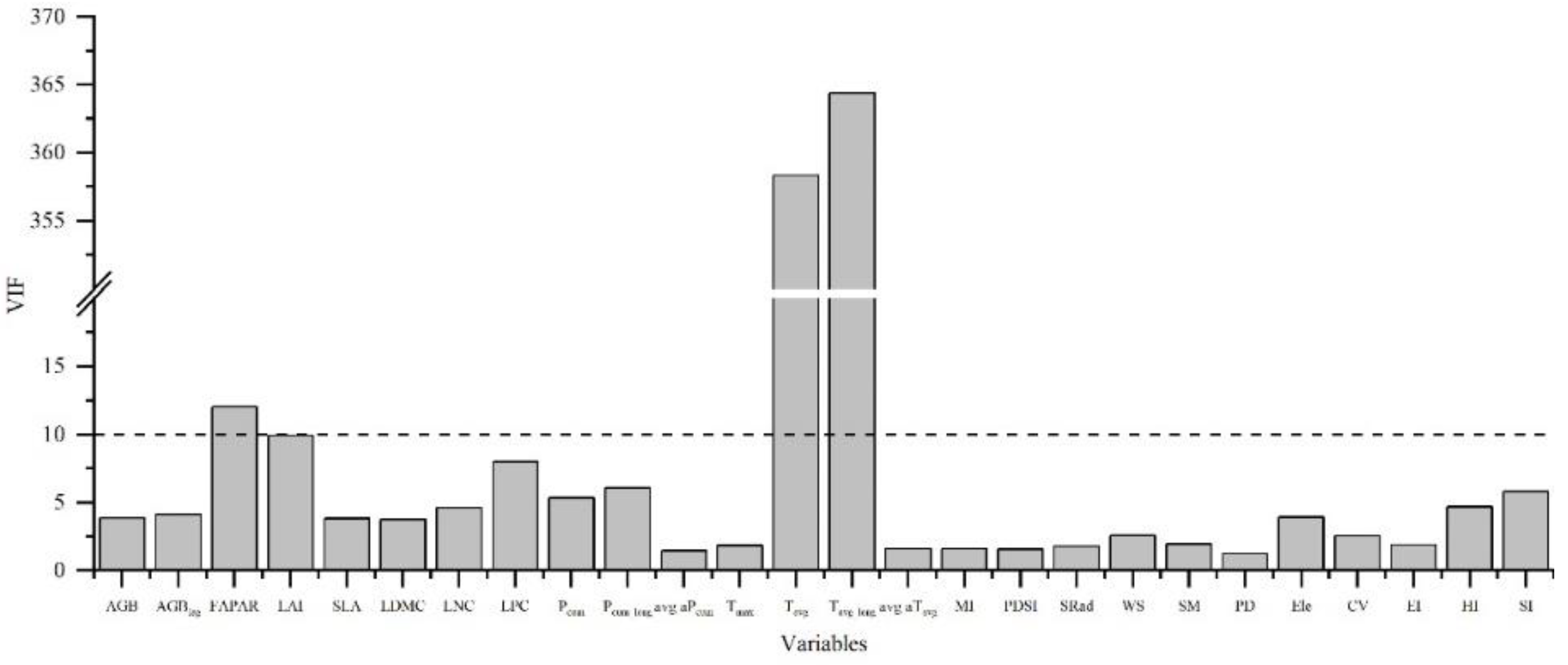
References
- Sturrock, R.N.; Frankel, S.J.; Brown, A.V.; Hennon, P.E.; Kliejunas, J.T.; Lewis, K.J.; Worrall, J.J.; Woods, A.J. Climate Change and Forest Diseases. Plant Pathol. 2011, 60, 133–149. [Google Scholar] [CrossRef]
- Malhi, Y.; Franklin, J.; Seddon, N.; Solan, M.; Turner, M.G.; Field, C.B.; Knowlton, N. Climate Change and Ecosystems: Threats, Opportunities and Solutions. Philos. Trans. R. Soc. B Biol. Sci. 2020, 375, 20190104. [Google Scholar] [CrossRef] [PubMed] [Green Version]
- Hassan, R.; Scholes, R.; Ash, N.; Condition, M.; Group, T. Ecosystems and Human Well-Being: Current State and Trends; Island Press: Washington, DC, USA, 2005. [Google Scholar]
- FAO. Global Forest Resources Assessment 2020; FAO: Rome, Italy, 2020; ISBN 978-92-5-132581-0. [Google Scholar]
- Pellegrini, A.F.A.; Refsland, T.; Averill, C.; Terrer, C.; Staver, A.C.; Brockway, D.G.; Caprio, A.; Clatterbuck, W.; Coetsee, C.; Haywood, J.D.; et al. Decadal Changes in Fire Frequencies Shift Tree Communities and Functional Traits. Nat. Ecol. Evol. 2021, 5, 504–512. [Google Scholar] [CrossRef]
- Zhao, B.; Zhuang, Q.; Shurpali, N.; Köster, K.; Berninger, F.; Pumpanen, J. North American Boreal Forests Are a Large Carbon Source Due to Wildfires from 1986 to 2016. Sci. Rep. 2021, 11, 7723. [Google Scholar] [CrossRef]
- Kitzberger, T.; Tiribelli, F.; Barberá, I.; Gowda, J.H.; Morales, J.M.; Zalazar, L.; Paritsis, J. Projections of Fire Probability and Ecosystem Vulnerability under 21st Century Climate across a Trans-Andean Productivity Gradient in Patagonia. Sci. Total Environ. 2022, 839, 156303. [Google Scholar] [CrossRef] [PubMed]
- Forzieri, G.; Girardello, M.; Ceccherini, G.; Spinoni, J.; Feyen, L.; Hartmann, H.; Beck, P.S.A.; Camps-Valls, G.; Chirici, G.; Mauri, A.; et al. Emergent Vulnerability to Climate-Driven Disturbances in European Forests. Nat. Commun. 2021, 12, 1081. [Google Scholar] [CrossRef]
- Battipaglia, G.; Rigling, A.; De Micco, V. Editorial: Multiscale Approach to Assess Forest Vulnerability. Front. Plant Sci. 2020, 11, 744. [Google Scholar] [CrossRef] [PubMed]
- Luo, H.; Wei, A.; Zhang, C. A comprehensive review of forest ecosystem vulnerability assessment research. Subtrop. Agric. Res. 2017, 13, 66–72. [Google Scholar]
- Meybeck, A.; Rose, A.; Gitz, V. FAO Framework Methodology for Climate Change Vulnerability Assessments of Forests and Forest Dependent People: A Framework Methodology; FAO Forestry Papers; FAO: Rome, Italy, 2019; ISBN 978-92-5-131981-9. [Google Scholar]
- Li, K.; Chen, Y. Analysis of Vulnerability of Forest in China Responsed to Global Climate Change. Acta Geogr. Sin. 1996, 51, 40–49. [Google Scholar]
- Dale, V.H.; Joyce, L.A.; McNulty, S.; Neilson, R.P.; Ayres, M.P.; Flannigan, M.D.; Hanson, P.J.; Irland, L.C.; Lugo, A.E.; Peterson, C.J.; et al. Climate Change and Forest Disturbances: Climate Change Can Affect Forests by Altering the Frequency, Intensity, Duration, and Timing of Fire, Drought, Introduced Species, Insect and Pathogen Outbreaks, Hurricanes, Windstorms, Ice Storms, or Landslides. BioScience 2001, 51, 723–734. [Google Scholar] [CrossRef] [Green Version]
- Seidl, R.; Thom, D.; Kautz, M.; Martin-Benito, D.; Peltoniemi, M.; Vacchiano, G.; Wild, J.; Ascoli, D.; Petr, M.; Honkaniemi, J.; et al. Forest Disturbances under Climate Change. Nat. Clim. Chang. 2017, 7, 395–402. [Google Scholar] [CrossRef] [PubMed] [Green Version]
- Viljur, M.-L.; Abella, S.R.; Adámek, M.; Alencar, J.B.R.; Barber, N.A.; Beudert, B.; Burkle, L.A.; Cagnolo, L.; Campos, B.R.; Chao, A.; et al. The Effect of Natural Disturbances on Forest Biodiversity: An Ecological Synthesis. Biol. Rev. 2022, 97, 1930–1947. [Google Scholar] [CrossRef] [PubMed]
- Lecina-Diaz, J.; Martínez-Vilalta, J.; Alvarez, A.; Banqué, M.; Birkmann, J.; Feldmeyer, D.; Vayreda, J.; Retana, J. Characterizing Forest Vulnerability and Risk to Climate-Change Hazards. Front. Ecol. Environ. 2021, 19, 126–133. [Google Scholar] [CrossRef]
- Shit, P.K.; Pourghasemi, H.R.; Adhikary, P.P.; Bhunia, G.S.; Sati, V.P. (Eds.) Forest Resources Resilience and Conflicts; Elsevier: Amsterdam, The Netherlands, 2021; ISBN 978-0-12-822931-6. [Google Scholar]
- Abatzoglou, J.T.; Williams, A.P. Impact of Anthropogenic Climate Change on Wildfire across Western US Forests. Proc. Natl. Acad. Sci. USA 2016, 113, 11770–11775. [Google Scholar] [CrossRef] [PubMed] [Green Version]
- Canadell, J.G.; Meyer, C.P.M.; Cook, G.D.; Dowdy, A.; Briggs, P.R.; Knauer, J.; Pepler, A.; Haverd, V. Multi-Decadal Increase of Forest Burned Area in Australia Is Linked to Climate Change. Nat. Commun. 2021, 12, 6921. [Google Scholar] [CrossRef] [PubMed]
- Li, W.; Xu, Q.; Yi, J.; Liu, J. Predictive Model of Spatial Scale of Forest Fire Driving Factors: A Case Study of Yunnan Province, China. Sci. Rep. 2022, 12, 19029. [Google Scholar] [CrossRef]
- Liu, H.; Xiong, K.; Yu, Y.; Li, T.; Qing, Y.; Wang, Z.; Zhang, S. A Review of Forest Ecosystem Vulnerability and Resilience: Implications for the Rocky Desertification Control. Sustainability 2021, 13, 11849. [Google Scholar] [CrossRef]
- Amalina, P.; Prasetyo, L.B.; Rushayati, S.B. Forest Fire Vulnerability Mapping in Way Kambas National Park. Procedia Environ. Sci. 2016, 33, 239–252. [Google Scholar] [CrossRef] [Green Version]
- Buotte, P.C.; Levis, S.; Law, B.E.; Hudiburg, T.W.; Rupp, D.E.; Kent, J.J. Near-Future Forest Vulnerability to Drought and Fire Varies across the Western United States. Glob. Chang. Biol. 2019, 25, 290–303. [Google Scholar] [CrossRef] [PubMed] [Green Version]
- Li, J.; Xu, D.; Management, T.; University, S.N. Evaluation on Exploitation Potential of Forest Health Tourism Based on Ahp and Fuzzy Synthetic Evalution—A Case Study of Liaodong Mountain Area. Chin. J. Agric. Resour. Reg. Plan. 2018, 39, 135–142. [Google Scholar]
- Giglio, E. Landscape Ecological Method to Study Agricultural Vegetation: Some Examples from the Po Valley. Ann. Bot. 2006, 6, 95–110. [Google Scholar]
- Delgado, A.; Vidal, J.; Castro, J.; Felix, J.; Saenz, J. Assessment of Surface Water Quality on the Upper Watershed of Huallaga River, in Peru, Using Grey Systems and Shannon Entropy. Int. J. Adv. Comput. Sci. Appl. 2020, 11, 437–444. [Google Scholar] [CrossRef]
- Xenarios, S.; Nemes, A.; Sarker, G.W.; Sekhar, N.U. Assessing Vulnerability to Climate Change: Are Communities in Flood-Prone Areas in Bangladesh More Vulnerable than Those in Drought-Prone Areas? Water Resour. Rural Dev. 2016, 7, 1–19. [Google Scholar] [CrossRef]
- Abu El-Magd, S.A.; Maged, A.; Farhat, H.I. Hybrid-Based Bayesian Algorithm and Hydrologic Indices for Flash Flood Vulnerability Assessment in Coastal Regions: Machine Learning, Risk Prediction, and Environmental Impact. Environ. Sci. Pollut. Res. 2022, 29, 57345–57356. [Google Scholar] [CrossRef] [PubMed]
- Hutter, F.; Kotthoff, L.; Vanschoren, J. (Eds.) Automated Machine Learning: Methods, Systems, Challenges; Springer Nature: Cham, Switzerland, 2019. [Google Scholar]
- LeDell, E.; Poirier, S. H2O AutoML: Scalable automatic machine learning. In Proceedings of the 7th ICML Workshop on Automated Machine Learning, Vienna, Austria, 17–18 July 2020; p. 16. [Google Scholar]
- National Forestry and Grassland Administration. China Forestry and Grassland Statistical Yearbook; China Forestry Publishing House: Beijing, China, 2019.
- Luan, T.; Wang, Y.; Zhang, X. Statistical Analysis of Forest Fire Accidents in China from 2008 to 2018. Saf. Secur. 2020, 41, 7. [Google Scholar]
- Wang, M.; Shu, L. Responses and Variations of Forest Fires in China under Changing Climate; Science Press: Beijing, China, 2015. [Google Scholar]
- Fang, L.; Yang, J.; Zu, J.; Li, G.; Zhang, J. Quantifying Influences and Relative Importance of Fire Weather, Topography, and Vegetation on Fire Size and Fire Severity in a Chinese Boreal Forest Landscape. For. Ecol. Manag. 2015, 356, 2–12. [Google Scholar] [CrossRef]
- Ying, L.; Han, J.; Du, Y.; Shen, Z. Forest Fire Characteristics in China: Spatial Patterns and Determinants with Thresholds. For. Ecol. Manag. 2018, 424, 345–354. [Google Scholar] [CrossRef]
- Zhao, F.; Liu, Y. Atmospheric Circulation Patterns Associated with Wildfires in the Monsoon Regions of China. Geophys. Res. Lett. 2019, 46, 4873–4882. [Google Scholar] [CrossRef] [Green Version]
- White, J.C.; Coops, N.C.; Wulder, M.A.; Vastaranta, M.; Hilker, T.; Tompalski, P. Remote Sensing Technologies for Enhancing Forest Inventories: A Review. Can. J. Remote Sens. 2016, 42, 619–641. [Google Scholar] [CrossRef] [Green Version]
- Francini, S.; McRoberts, R.E.; D’Amico, G.; Coops, N.C.; Hermosilla, T.; White, J.C.; Wulder, M.A.; Marchetti, M.; Mugnozza, G.S.; Chirici, G. An Open Science and Open Data Approach for the Statistically Robust Estimation of Forest Disturbance Areas. Int. J. Appl. Earth Obs. Geoinf. 2022, 106, 102663. [Google Scholar] [CrossRef]
- Babaeian, E.; Paheding, S.; Siddique, N.; Devabhaktuni, V.K.; Tuller, M. Estimation of Root Zone Soil Moisture from Ground and Remotely Sensed Soil Information with Multisensor Data Fusion and Automated Machine Learning. Remote Sens. Environ. 2021, 260, 112434. [Google Scholar] [CrossRef]
- Pérez-Porras, F.-J.; Triviño-Tarradas, P.; Cima-Rodríguez, C.; Meroño-de-Larriva, J.-E.; García-Ferrer, A.; Mesas-Carrascosa, F.-J. Machine Learning Methods and Synthetic Data Generation to Predict Large Wildfires. Sensors 2021, 21, 3694. [Google Scholar] [CrossRef] [PubMed]
- Polsky, C.; Neff, R.; Yarnal, B. Building Comparable Global Change Vulnerability Assessments: The Vulnerability Scoping Diagram. Glob. Environ. Chang. 2007, 17, 472–485. [Google Scholar] [CrossRef]
- Thakur, S.; Negi, V.S.; Dhyani, R.; Satish, K.V.; Bhatt, I.D. Vulnerability Assessments of Mountain Forest Ecosystems: A Global Synthesis. Trees For. People 2021, 6, 100156. [Google Scholar] [CrossRef]
- Yin, Y.; Ma, D.; Wu, S. Climate Change Risk to Forests in China Associated with Warming. Sci. Rep. 2018, 8, 493. [Google Scholar] [CrossRef] [PubMed]
- Fang, J.; Shen, Z.; Tang, Z.; Wang, X.; Wang, Z.; Feng, J.; Liu, Y.; Qiao, X.; Wu, X.; Zheng, C. Forest Community Survey and the Structural Characteristics of Forests in China. Ecography 2012, 35, 1059–1071. [Google Scholar] [CrossRef]
- DiMiceli, C.; Carroll, M.; Sohlberg, R.; Kim, D.-H.; Kelly, M.; Townshend, J. MOD44B MODIS/Terra Vegetation Continuous Fields Yearly L3 Global 250 m SIN Grid V006 2017. Available online: https://www.fao.org/3/I8661EN/i8661en.pdf (accessed on 10 October 2022).
- Food and Agriculture Organization of the United Nations. Global Forest Resources Assessment 2020; Terms and Definitions: Rome, Italy, 2018. [Google Scholar]
- Sun, S. Concerning the Vegetation Chinese Regionalization Map as a Part of in the Natural Geographical Atlas of the People’s Republic of China. Acta Phytoecol. Sin. 1998, 22, 523–537. [Google Scholar]
- Hou, X. Vegetation Geography of China; Science Press: Beijing, China, 1988. [Google Scholar]
- Artés, T.; Oom, D.; de Rigo, D.; Durrant, T.H.; Maianti, P.; Libertà, G.; San-Miguel-Ayanz, J. A Global Wildfire Dataset for the Analysis of Fire Regimes and Fire Behaviour. Sci. Data 2019, 6, 296. [Google Scholar] [CrossRef] [Green Version]
- Santoro, M.; Cartus, O.; Carvalhais, N.; Rozendaal, D.M.A.; Avitabile, V.; Araza, A.; de Bruin, S.; Herold, M.; Quegan, S.; Rodríguez-Veiga, P.; et al. The Global Forest Above-Ground Biomass Pool for 2010 Estimated from High-Resolution Satellite Observations. Earth Syst. Sci. Data 2021, 13, 3927–3950. [Google Scholar] [CrossRef]
- James, G.; Witten, D.; Hastie, T.; Tibshirani, R. An introduction to statistical learning. In An Introduction to Statistical Learning, 8th ed.; James, G., Witten, D., Hastie, T., Tibshirani, R., Eds.; Springer Texts in Statistics; Springer: New York, NY, USA, 2017; ISBN 978-1-4614-7138-7. [Google Scholar]
- Thompson, C.G.; Kim, R.S.; Aloe, A.M.; Becker, B.J. Extracting the Variance Inflation Factor and Other Multicollinearity Diagnostics from Typical Regression Results. Basic Appl. Soc. Psychol. 2017, 39, 81–90. [Google Scholar] [CrossRef]
- Folli, G.S.; Nascimento, M.H.C.; de Paulo, E.H.; da Cunha, P.H.P.; Romão, W.; Filgueiras, P.R. Variable Selection in Support Vector Regression Using Angular Search Algorithm and Variance Inflation Factor. J. Chemom. 2020, 34, e3282. [Google Scholar] [CrossRef]
- Al-Sahaf, H.; Bi, Y.; Chen, Q.; Lensen, A.; Mei, Y.; Sun, Y.; Tran, B.; Xue, B.; Zhang, M. A Survey on Evolutionary Machine Learning. J. R. Soc. N. Z. 2019, 49, 205–228. [Google Scholar] [CrossRef]
- Karmaker, S.K.; Hassan, M.M.; Smith, M.J.; Xu, L.; Zhai, C.; Veeramachaneni, K. AutoML to Date and Beyond: Challenges and Opportunities. ACM Comput. Surv. 2021, 54, 1–36. [Google Scholar] [CrossRef]
- McCulloch, W.S.; Pitts, W. A Logical Calculus of the Ideas Immanent in Nervous Activity. Bull. Math. Biophys. 1943, 5, 115–133. [Google Scholar] [CrossRef]
- Cireşan, D.C.; Meier, U.; Gambardella, L.M.; Schmidhuber, J. Deep, Big, Simple Neural Nets for Handwritten Digit Recognition. Neural Comput. 2010, 22, 3207–3220. [Google Scholar] [CrossRef] [Green Version]
- Senn, S. A Conversation with John Nelder. Stat. Sci. 2003, 18, 118–131. [Google Scholar] [CrossRef]
- Kateri, M. Generalized linear models and extensions. In Contingency Table Analysis: Methods and Implementation Using R; Kateri, M., Ed.; Statistics for Industry and Technology; Springer: New York, NY, USA, 2014; pp. 125–152. ISBN 978-0-8176-4811-4. [Google Scholar]
- Mason, L.; Baxter, J.; Bartlett, P.; Frean, M. Boosting Algorithms as Gradient Descent. Adv. Neural Inf. Process. Syst. 1999, 12, 512–518. [Google Scholar]
- Piryonesi, S.M.; El-Diraby, T.E. Data Analytics in Asset Management: Cost-Effective Prediction of the Pavement Condition Index. J. Infrastruct. Syst. 2020, 26, 4019036. [Google Scholar] [CrossRef]
- Niculescu-Mizil, A.; Caruana, R. Predicting good probabilities with supervised learning. In Proceedings of the 22nd International Conference on Machine Learning—ICML ’05, Bonn, Germany, 7–11 August 2005; ACM Press: Bonn, Germany, 2005; pp. 625–632. [Google Scholar]
- Geurts, P.; Ernst, D.; Wehenkel, L. Extremely Randomized Trees. Mach. Learn. 2006, 63, 3–42. [Google Scholar] [CrossRef] [Green Version]
- Opitz, D.; Maclin, R. Popular Ensemble Methods: An Empirical Study. J. Artif. Intell. Res. 1999, 11, 169–198. [Google Scholar] [CrossRef]
- Fisher, A.; Rudin, C.; Dominici, F. All Models Are Wrong, but Many Are Useful: Learning a Variable’s Importance by Studying an Entire Class of Prediction Models Simultaneously. J. Mach. Learn. Res. 2019, 20, 1–81. [Google Scholar]
- Abdi, A.M.; Vrieling, A.; Yengoh, G.T.; Anyamba, A.; Seaquist, J.W.; Ummenhofer, C.C.; Ardö, J. The El Niño—La Niña Cycle and Recent Trends in Supply and Demand of Net Primary Productivity in African Drylands. Clim. Chang. 2016, 138, 111–125. [Google Scholar] [CrossRef] [Green Version]
- Wang, W.; Zhang, Q.; Luo, J.; Zhao, R.; Zhang, Y. Estimation of Forest Fire Emissions in Southwest China from 2013 to 2017. Atmosphere 2020, 11, 15. [Google Scholar] [CrossRef] [Green Version]
- Chen, A.; Tang, R.; Mao, J.; Yue, C.; Li, X.; Gao, M.; Shi, X.; Jin, M.; Ricciuto, D.; Rabin, S.; et al. Spatiotemporal Dynamics of Ecosystem Fires and Biomass Burning-Induced Carbon Emissions in China over the Past Two Decades. Geogr. Sustain. 2020, 1, 47–58. [Google Scholar] [CrossRef]
- Zhu, J.; Zhou, X.; Hu, J. Thoughts and views about the three north shelterbelt program. J. Nat. Resour. 2004, 19, 79–85. [Google Scholar] [CrossRef]
- Lu, F.; Hu, H.; Sun, W.; Zhu, J.; Liu, G.; Zhou, W.; Zhang, Q.; Shi, P.; Liu, X.; Wu, X.; et al. Effects of National Ecological Restoration Projects on Carbon Sequestration in China from 2001 to 2010. Proc. Natl. Acad. Sci. USA 2018, 115, 4039–4044. [Google Scholar] [CrossRef] [Green Version]
- Yu, D.; Zhou, L.; Zhou, W.; Ding, H.; Wang, Q.-W.; Wang, Y.; Wu, X.; Dai, L. Forest Management in Northeast China: History, Problems, and Challenges. Environ. Manag. 2011, 48, 1122–1135. [Google Scholar] [CrossRef]
- Fan, Q.; Wang, C.; Zhang, D.; Zang, S. Environmental Influences on Forest Fire Regime in the Greater Hinggan Mountains, Northeast China. Forests 2017, 8, 372. [Google Scholar] [CrossRef]
- Seiler, W.; Crutzen, P.J. Estimates of Gross and Net Fluxes of Carbon between the Biosphere and the Atmosphere from Biomass Burning. Clim. Chang. 1980, 2, 207–247. [Google Scholar] [CrossRef]
- Song, Y.; Liu, B.; Miao, W.; Chang, D.; Zhang, Y. Spatiotemporal Variation in Nonagricultural Open Fire Emissions in China from 2000 to 2007. Glob. Biogeochem. Cycles 2009, 23, 1–13. [Google Scholar] [CrossRef]
- Lü, A.; Tian, H.; Liu, M.; Liu, J.; Melillo, J.M. Spatial and Temporal Patterns of Carbon Emissions from Forest Fires in China from 1950 to 2000. J. Geophys. Res. Atmos. 2006, 111. [Google Scholar] [CrossRef] [Green Version]
- Chen, W.; Feng, Y.; Zhang, J.; Zhang, L. Response of Soil Lignin Stability to Nitrogen Addition and Precipitation Reduction in Broad-Leaved Korean Pine Forest. CJE 2019, 38, 99–106. [Google Scholar]
- Piao, S.; Wang, X.; Park, T.; Chen, C. Characteristics, Drivers and Feedbacks of Global Greening. Nat. Rev. Earth Environ. 2020, 1, 14–27. [Google Scholar] [CrossRef] [Green Version]
- Liu, Y.; Lu, C.; Fu, B.-J.; Yu, B. Terrestrial Ecosystem Classification and Its Spatiotemporal Changes in China during Last 20 Years. Acta Ecol. Sin. 2021, 41, 3975–3987. [Google Scholar] [CrossRef]
- Satendra, K.A. Forest Fire Disaster Management; National Institute of Disaster Management, Ministry of Home Affairs (NIDM): New Delhi, India, 2014; ISBN 978-93-82571-09-4.
- Morimoto, J.; Nakagawa, K.; Takano, K.T.; Aiba, M.; Oguro, M.; Furukawa, Y.; Mishima, Y.; Ogawa, K.; Ito, R.; Takemi, T.; et al. Comparison of Vulnerability to Catastrophic Wind between Abies Plantation Forests and Natural Mixed Forests in Northern Japan. Forestry 2019, 92, 436–443. [Google Scholar] [CrossRef]
- Masson-Delmotte, V.; Zhai, P.; Pörtner, H.-O.; Roberts, D.; Skea, J. Global Warming of 1.5 °C. An IPCC Special Report on the Impacts of Global Warming of 1.5 °C above Pre-Industrial Levels and Related Global Greenhouse Gas Emission Pathways, in the Context of Strengthening the Global Response to the Threat of Climate Change, Sustainable Development, and Efforts to Eradicate Poverty. Available online: https://www.ipcc.ch/sr15/ (accessed on 13 January 2022).
- Moreno-Martínez, Á.; Camps-Valls, G.; Kattge, J.; Robinson, N.; Reichstein, M.; van Bodegom, P.; Kramer, K.; Cornelissen, J.H.C.; Reich, P.; Bahn, M.; et al. A Methodology to Derive Global Maps of Leaf Traits Using Remote Sensing and Climate Data. Remote Sens. Environ. 2018, 218, 69–88. [Google Scholar] [CrossRef] [Green Version]
- De Martonne, E. Une Nouvelle Fonction Climatologique: L’Indice d’Aridité; Impr. Gauthier-Villars: Paris, France, 1926. [Google Scholar]
- Tuanmu, M.-N.; Jetz, W. A Global, Remote Sensing-Based Characterization of Terrestrial Habitat Heterogeneity for Biodiversity and Ecosystem Modelling. Glob. Ecol. Biogeogr. 2015, 24, 1329–1339. [Google Scholar] [CrossRef]

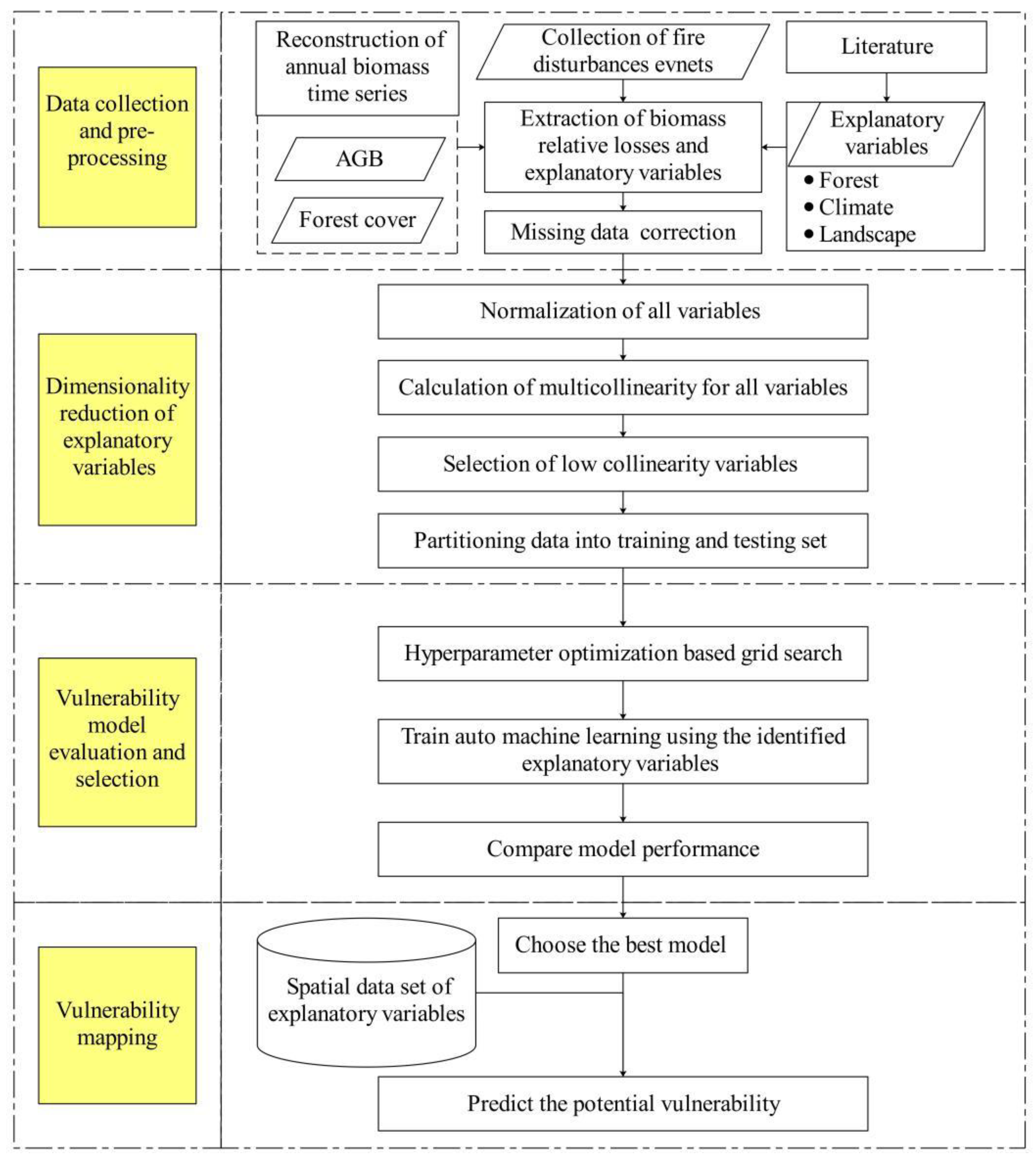

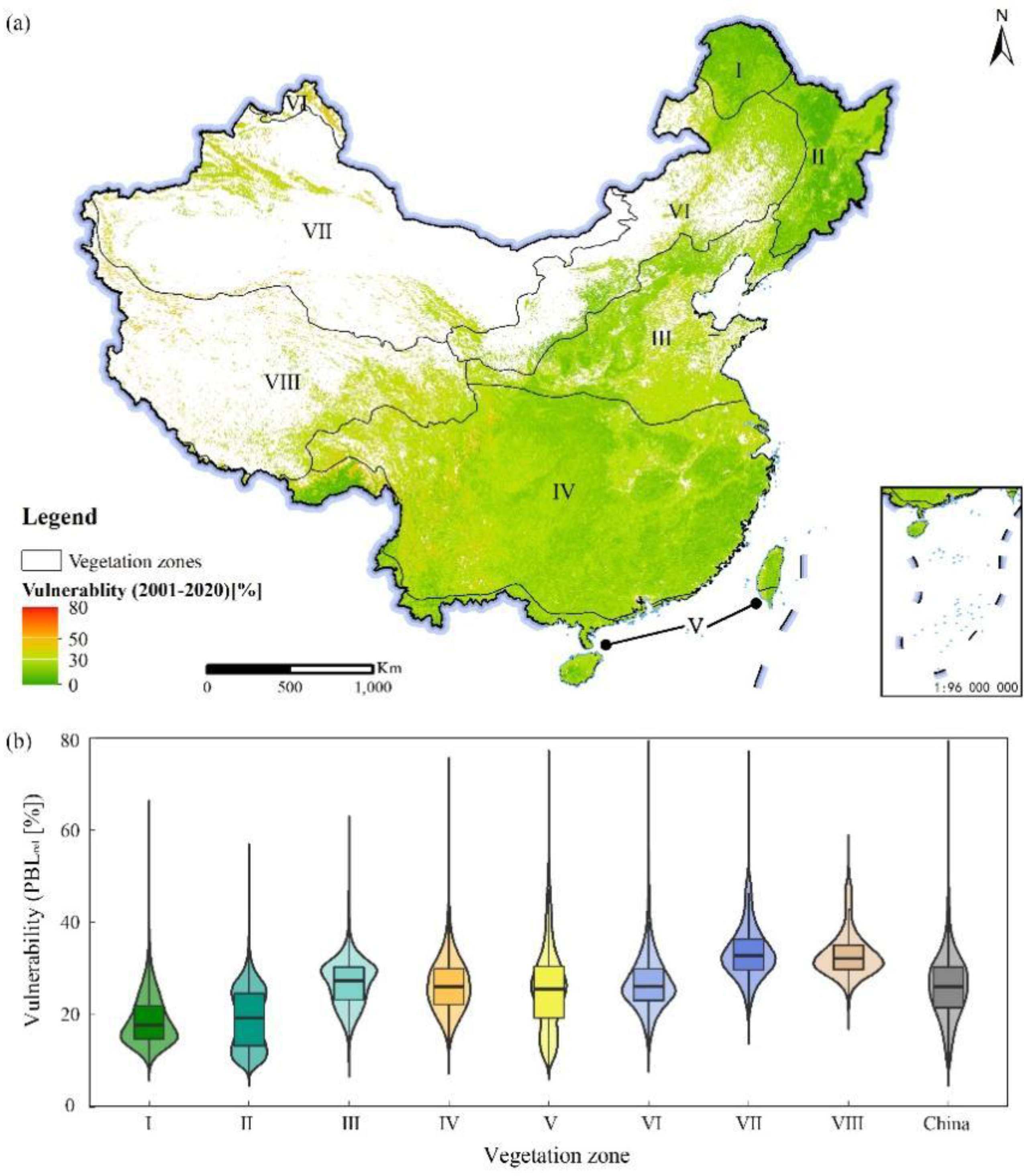
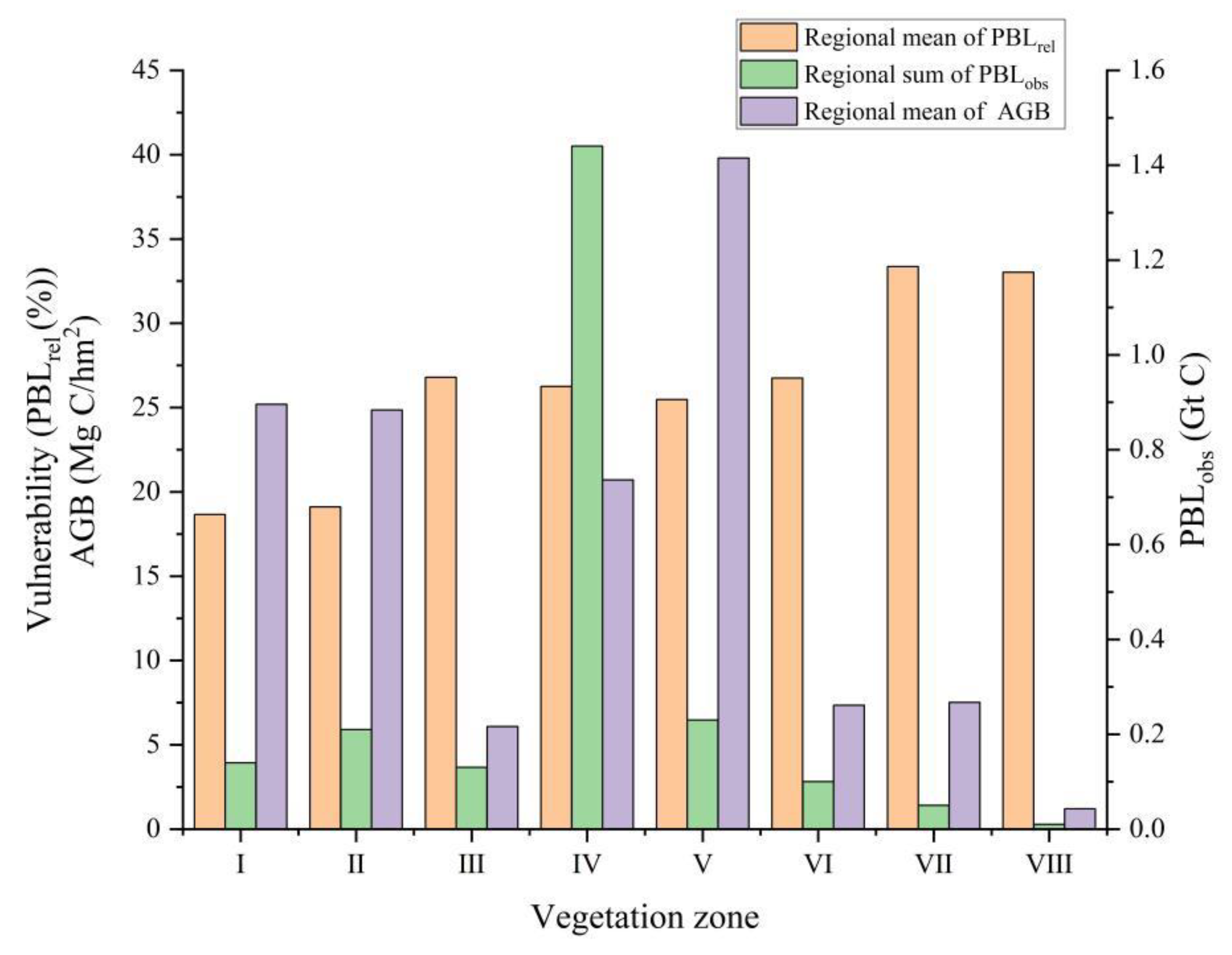

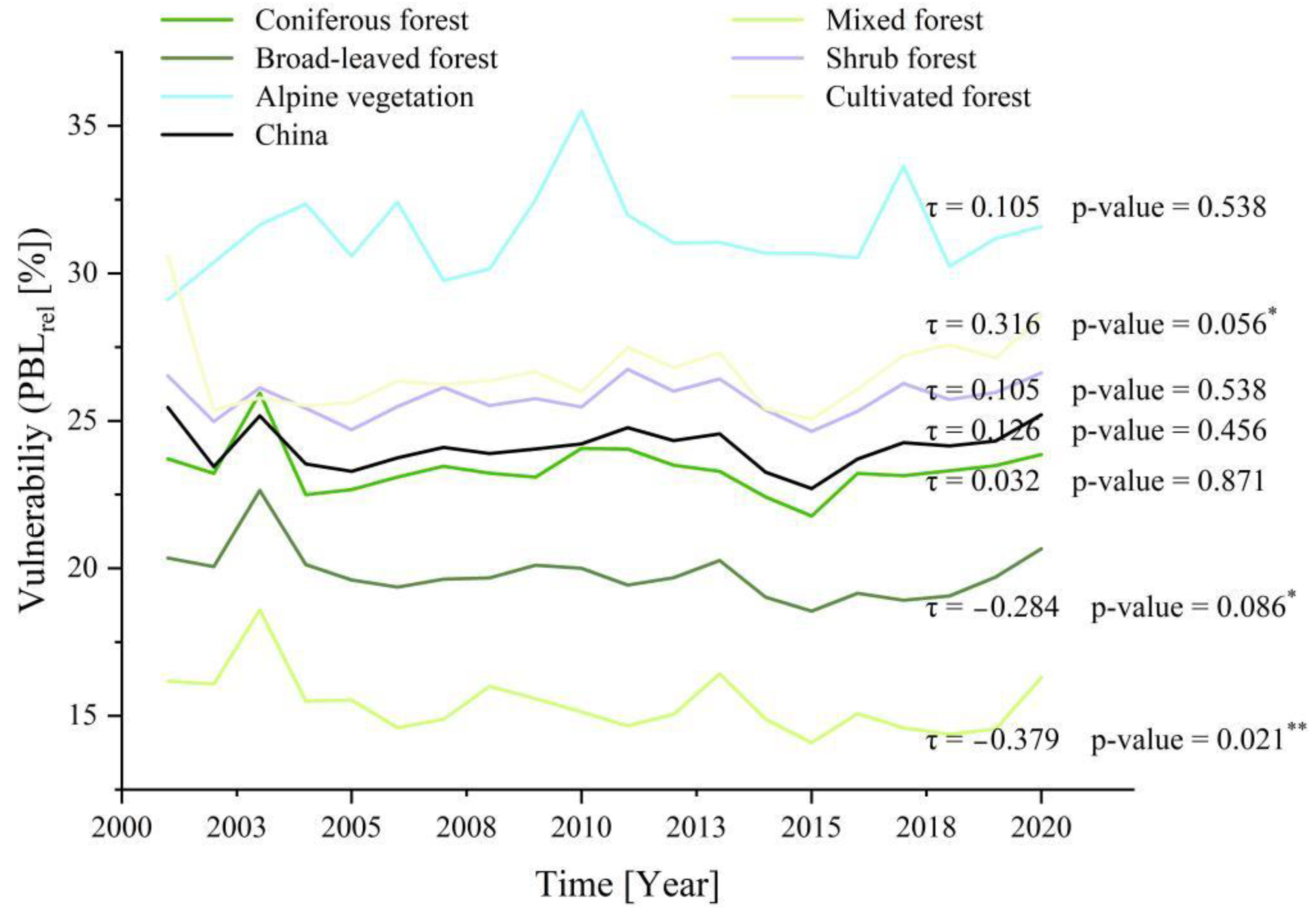
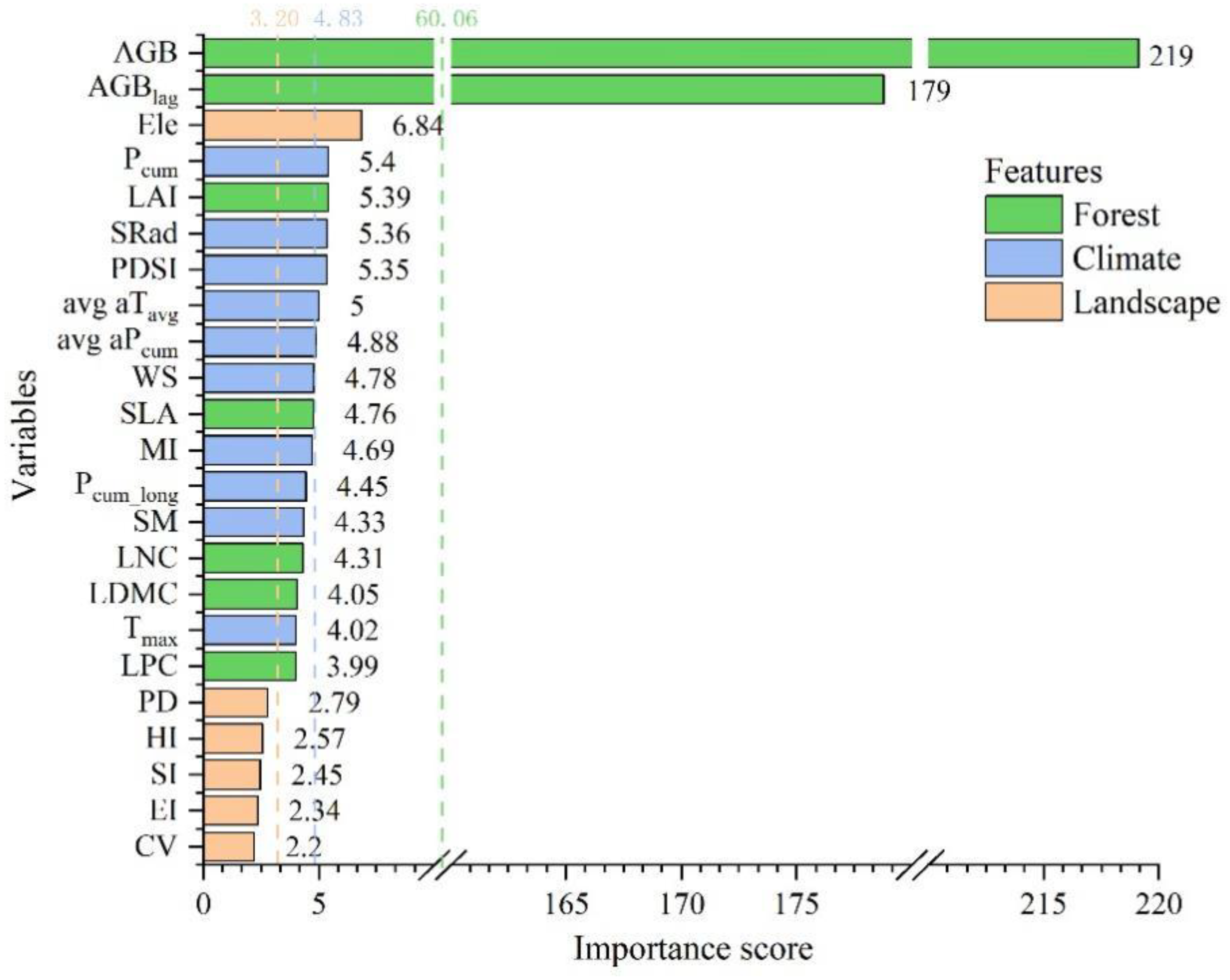

| Category | Explanatory Variables | Abbreviation | Temporal Resolution |
|---|---|---|---|
| Forest features | Aboveground biomass | AGB | Yearly |
| one-year-lagged aboveground biomass | AGBlag | Yearly | |
| Leaf area index | LAI | Yearly | |
| Fraction of absorbed photosynthetically active radiation | FAPAR | Yearly | |
| Specific leaf area | SLA | Static | |
| Leaf dry matter content | LDMC | Static | |
| Leaf nitrogen content per leaf dry mass | LNC | Static | |
| Leaf phosphorus content per leaf dry mass | LPC | Static | |
| Climate features | Annual cumulated precipitation | Pcum | Yearly |
| Annual average temperature | Tavg | Yearly | |
| Annual maximum temperature | Tmax | Yearly | |
| Annual values of downward surface Shortwave radiation | SRad | Yearly | |
| Palmer drought severity index | PDSI | Yearly | |
| Soil moisture | SM | Yearly | |
| Long-term mean precipitation | Pcum_long | Static | |
| Short-term average anomaly in cumulated precipitation | avg aPcum | Yearly | |
| Long-term mean temperature | Tavg_long | Static | |
| Short-term average anomaly in average temperature | avg aTavg | Yearly | |
| Moisture index | MI | Yearly | |
| Landscape features | Coefficient of variation | CV | Static |
| Evenness index | EI | Static | |
| Shannon Index | SI | Static | |
| Homogeneity index | HI | Static | |
| Elevation | Ele | Static | |
| Population density | PD | Yearly |
| Number | Model ID | RMSE | MSE | MAE | RMSLE |
|---|---|---|---|---|---|
| 1 | StackedEnsemble_AllModels | 0.095 | 0.009 | 0.067 | 0.074 |
| 2 | StackedEnsemble_BestOfFamily | 0.097 | 0.009 | 0.069 | 0.075 |
| 3 | GBM_4_AutoML | 0.098 | 0.010 | 0.069 | 0.076 |
| 4 | GBM_3_AutoML | 0.098 | 0.010 | 0.070 | 0.076 |
| 5 | GBM_grid__1_AutoML_model_1 | 0.099 | 0.010 | 0.070 | 0.077 |
| 6 | GBM_2_AutoML | 0.099 | 0.010 | 0.070 | 0.077 |
| 7 | GBM_1_AutoML | 0.100 | 0.010 | 0.071 | 0.077 |
| 8 | GBM_grid__1_AutoML_model_4 | 0.100 | 0.010 | 0.071 | 0.077 |
| 9 | GBM_5 | 0.101 | 0.010 | 0.072 | 0.078 |
| 10 | GBM_grid__1_AutoML_model_8 | 0.102 | 0.010 | 0.075 | 0.079 |
| 11 | GBM_grid__1_AutoML_model_10 | 0.104 | 0.011 | 0.076 | 0.080 |
| 12 | GBM_grid__1_AutoML_model_7 | 0.104 | 0.011 | 0.076 | 0.080 |
| 13 | GBM_grid__1_AutoML_model_3 | 0.104 | 0.011 | 0.076 | 0.080 |
| 14 | GBM_grid__1_AutoML_model_6 | 0.104 | 0.011 | 0.076 | 0.081 |
| 15 | GBM_grid__1_AutoML_model_11 | 0.105 | 0.011 | 0.078 | 0.081 |
| 16 | DRF_1 | 0.106 | 0.011 | 0.080 | 0.082 |
| 17 | XRT_1 | 0.106 | 0.011 | 0.080 | 0.082 |
| 18 | GBM_grid__1_AutoML_model_9 | 0.108 | 0.012 | 0.082 | 0.084 |
| 19 | GBM_grid__1_AutoML_model_5 | 0.108 | 0.012 | 0.082 | 0.084 |
| 20 | GLM_1 | 0.139 | 0.019 | 0.110 | 0.107 |
| 21 | DeepLearning_1_AutoML | 0.149 | 0.022 | 0.108 | 0.116 |
| 22 | DeepLearning_grid__1 | 0.153 | 0.024 | 0.118 | 0.119 |
| 23 | DeepLearning_grid__2 | 0.175 | 0.031 | 0.128 | 0.133 |
| 24 | DeepLearning_grid__3 | 0.201 | 0.040 | 0.165 | 0.154 |
Publisher’s Note: MDPI stays neutral with regard to jurisdictional claims in published maps and institutional affiliations. |
© 2022 by the authors. Licensee MDPI, Basel, Switzerland. This article is an open access article distributed under the terms and conditions of the Creative Commons Attribution (CC BY) license (https://creativecommons.org/licenses/by/4.0/).
Share and Cite
Ren, H.; Zhang, L.; Yan, M.; Chen, B.; Yang, Z.; Ruan, L. Spatiotemporal Assessment of Forest Fire Vulnerability in China Using Automated Machine Learning. Remote Sens. 2022, 14, 5965. https://doi.org/10.3390/rs14235965
Ren H, Zhang L, Yan M, Chen B, Yang Z, Ruan L. Spatiotemporal Assessment of Forest Fire Vulnerability in China Using Automated Machine Learning. Remote Sensing. 2022; 14(23):5965. https://doi.org/10.3390/rs14235965
Chicago/Turabian StyleRen, Hongge, Li Zhang, Min Yan, Bowei Chen, Zhenyu Yang, and Linlin Ruan. 2022. "Spatiotemporal Assessment of Forest Fire Vulnerability in China Using Automated Machine Learning" Remote Sensing 14, no. 23: 5965. https://doi.org/10.3390/rs14235965






